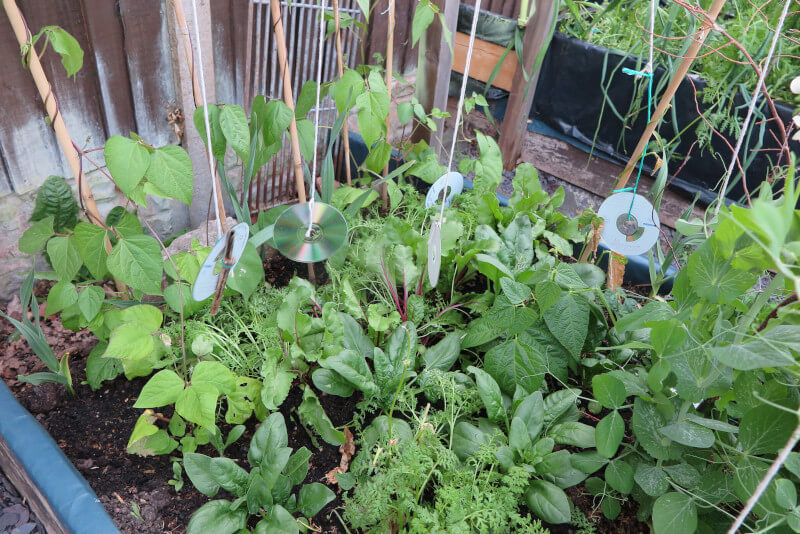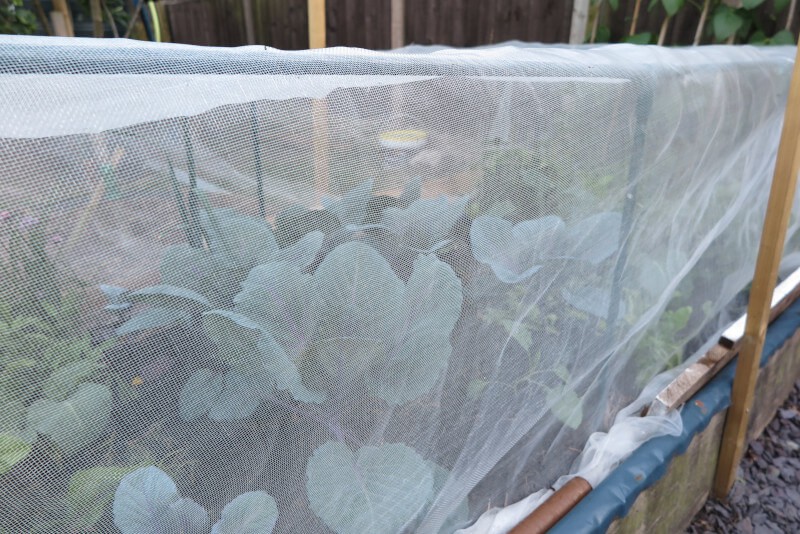Protection
Over the last few thousand years that we’ve grown food, the quality of the produce we have been growing has been bred to be sweeter and tastier. So not surprisingly the creatures that we share the planet with want a taste of it too! That is why we have to take some action if we want to make sure we have some left for us to eat. Your location will determine the sort of animals/insects that will attack your precious produce. I am not considering bigger creatures like rabbits and deer as the deterrent for these are well documented elsewhere. I am particularly interested in the gardener who is in a more urban setting.
Starting with the bigger pests, the garden birds love to peck out little seedlings as they appear in your bed. Just hang old CDs/DVDs on strings at different heights around the plants. Good heights are from just a touch higher than the seedlings to about 70 cm. The slightest of breeze will move these enough to scare sparrows and pigeons (main culprits) away.

Barrier
The least harmful method of protecting your plant against smaller creatures is to put some sort of barrier around it. This barrier has to let in sun light and rain, but keep out the most voracious creatures. This is where the protective nets come in. It is good to know what we are up against as the type of netting we need to use will vary. Some experienced gardeners will use different barriers at different times of year as the type of “pests” change, and take into account the different crops and their stages of growth. But this is getting too complex as a gardens and their environment will vary massively and strict rules will then become pointless. Lets then look at general protection methods that will be effective in most situations.
Do make sure that the barrier you choose is “UV stabilised”. This will help it last longer and is worth paying a little bit more for.
Fleece
Fleece sheets serve a dual purpose of keeping the seedlings warm in spring and making them inaccessible to some pests. However, when the plants get bigger it is best to graduate to a different method as fleece will block out too much of the sunlight. The cheap ones are not that durable but good horticultural ones should last a few seasons. A sheet larger than your growing bed will allow you to weigh the edges down with wood and stones.
Netting
Netting is a very effective barrier. The ones with bigger holes will keep the birds from polishing off your fruits, but allow pollinating insects to your blossoms. The second size down (butterfly netting) will also keep out the butterfly whose caterpillars can decimate your brassicas. Then the next size down will prevent carrot flies getting in too. These are sometimes called “insect mesh netting”. There is then the smallest “ultra-fine” mesh size that will also keep aphid and blackfly out. But the smaller mesh here can block much of the sun and rain that your plants need.
What you choose will depend on what you’re growing too. I believe a good compromise that will protect both brassicas and carrots is the “insect mesh” which will allow a good amount of sunlight and rain to reach the plants. If seedlings are not planted out till they are bigger and healthier, they can survive aphid attacks. Later in the season, ladybirds and lacewings will come on the scene to keep down the aphid numbers.

Do keep in mind that for fruiting plants like peas, courgettes and squashes, insects will be needed to pollinate their flowers, so covering them is not an option. I find that these plants are usually strong enough to resist pests when they allowed to mature before planting out.
Share
Keep in mind that early in the year, birds will have a scarcity of food. I allow Swiss chard (that has been very productive in summer) to overwinter and this provides young leaves that sparrows can peck at next spring. Then in later spring when the sparrows move onto more nutritious foods and you can harvest the leaves for your own table! So sharing some of your food with other creatures can be a win-win for both you and the planet.
Another point to keep in mind is that plants raised on a no-dig bed will be vital and healthy and can ward of quite a few pests that might decimate an unhealthy plant. So in this case there is only need provide the minimal of protection.